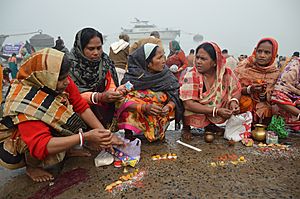Maghi facts for kids
Quick facts for kids Maghi |
|
|---|---|
| Observed by | Hindus and Sikhs of Punjab, Haryana, Himachal Pradesh and Jammu division |
| Type | Religious and Cultural |
| Significance | Midwinter festival, celebration of Winter Solstice |
| Celebrations | Ritual bathing, Madraison Puja, Masant, Eating traditional food |
| Begins | 1st Magh Sangrand Hindu calendar |
| Date | Lua error in Module:Wikidata at line 132: attempt to index field 'wikibase' (a nil value). |
| Frequency | Annual |
| Related to | Makar Sankranti |
Maghi is a special festival celebrated by Hindus and Sikhs in parts of India, like Punjab, Haryana, Jammu, and Himachal Pradesh. It's also known by other names, such as Maghi Saaji or Magha Ra Saza in Himachal, and Maghi Parva or Maghi Sankranti in Bihar and Nepal.
This festival happens on the very first day of the month of Magh in the Hindu calendar. It comes right after another winter festival called Lohri, which is famous for its bonfires. On Maghi morning, many people take a special bath in rivers or ponds.
Contents
Maghi: A Hindu Celebration
Maghi is also known as Makar Sankranti or Pongal in other parts of India. It always falls on the first day of the month of Magha in the Bikrami calendar. On this day, Hindus believe the sun begins its journey north.
Many people celebrate by taking a holy bath in the Ganges River. If that's not possible, they bathe in other rivers, canals, or ponds. This festival follows Lohri, which is very popular in northern India.
Maghi in Himachal Pradesh
In some areas of Himachal Pradesh, Maghi is called Magha Ra Saza. The month of Magh is the coldest time in the hills. Because farming slows down, this month is often spent honoring Agni Devta, the fire god.
In villages, the night of Lohri is part of the Maghi celebrations. This night is sometimes called Masant. Another important tradition for Maghi is Madraison Puja. During this ritual, homes are cleaned and beautifully decorated.
Maghi: A Sikh Celebration
For Sikhs, Maghi is a very important day for remembering brave heroes. It honors the Chalis Mukte, who were forty Sikh warriors. These warriors had left Guru Gobind Singh, the tenth Sikh Guru, but later returned to fight alongside him.
They bravely fought against the Mughal army in 1705 and gave their lives. Sikhs make a special trip to Muktsar Sahib, where the battle took place. They also take a dip in the holy water tanks there.
A big fair, called the Mela Maghi, is held every year at Muktsar Sahib. This fair remembers the forty Sikh martyrs. Even before this tradition started, the festival was observed by Guru Amar Das, the third Guru of Sikhism.
Cultural Traditions of Maghi
In Punjab, people celebrate Maghi by eating special foods. One old dish is Rauh di kheer, which is rice cooked in sugarcane juice. This sweet dish is made the evening before Maghi and left to cool. It's served cold the next morning with curd mixed with red chili.
In some parts of Punjab, it's also common to eat Khichdi, a dish made with rice and lentils. People also enjoy raw sugarcane and jaggery, which is a type of unrefined sugar. Many towns in Punjab hold fun fairs on Maghi.
See also
- Makar Sankranti
- Sankranti
- Thai Pongal
- Winter Solstice
- Lohri
- Maghe Sankranti


